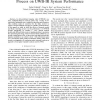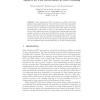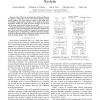346 search results - page 5 / 70 » PPM Model Cleaning |
LREC
2008
13 years 9 months ago
2008
Originally conceived as a "naive" baseline experiment using traditional n-gram language models as classifiers, the NCLEANER system has turned out to be a fast and lightw...
ICC
2007
IEEE
14 years 1 months ago
2007
IEEE
Abstract— In ultra-wideband impulse radio (UWB-IR) systems, multipath-delayed received pulses may overlap if two consecutive multipaths arrive within less than the pulse duration...
DAWAK
2011
Springer
12 years 7 months ago
2011
Springer
Data cleaning and ETL processes are usually modeled as graphs of data transformations. The involvement of the users responsible for executing these graphs over real data is importa...
ICDE
2010
IEEE
14 years 2 months ago
2010
IEEE
— One of the most prominent data quality problems is the existence of duplicate records. Current data cleaning systems usually produce one clean instance (repair) of the input da...
CAAN
2007
Springer
14 years 1 months ago
2007
Springer
In the recently introduced model for cleaning a graph with brushes, we use a degree-greedy algorithm to clean a random d-regular graph on n vertices (with dn even). We then use a d...



